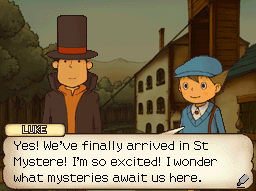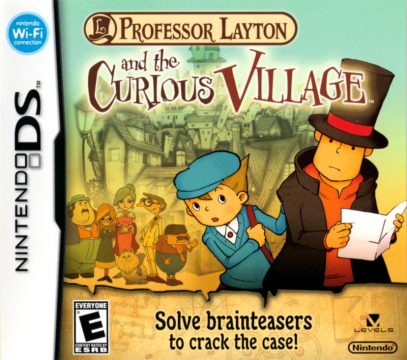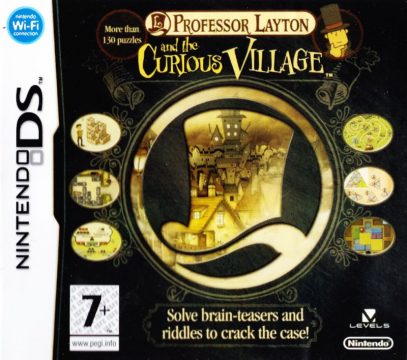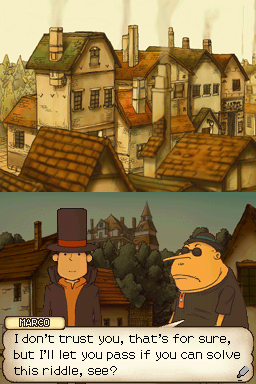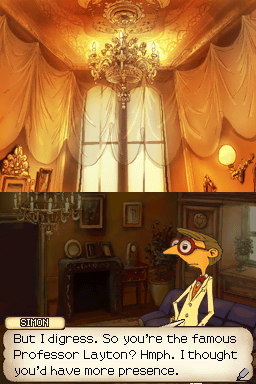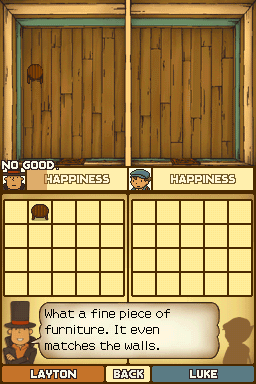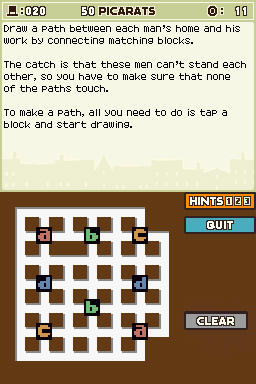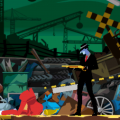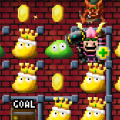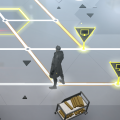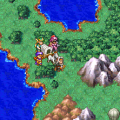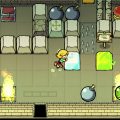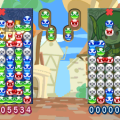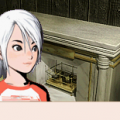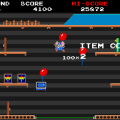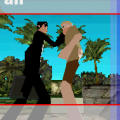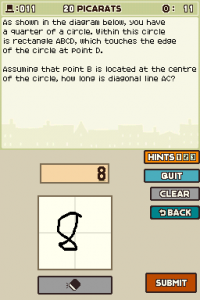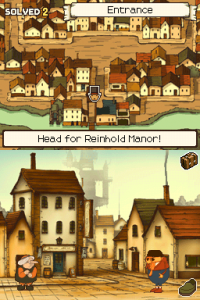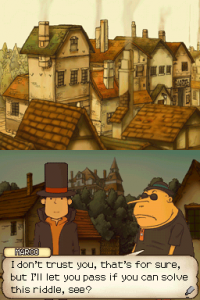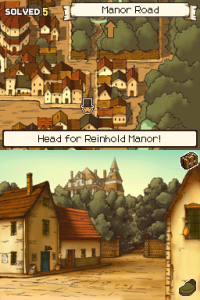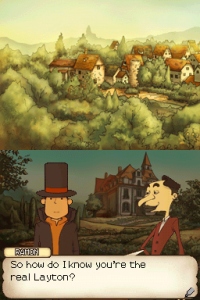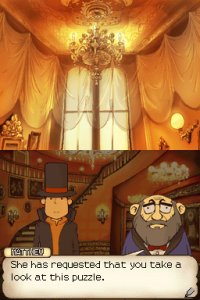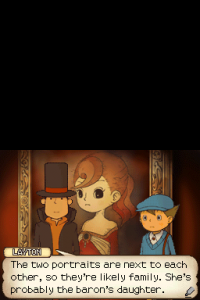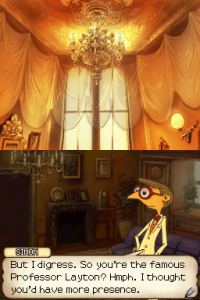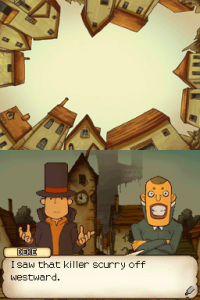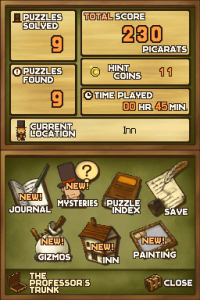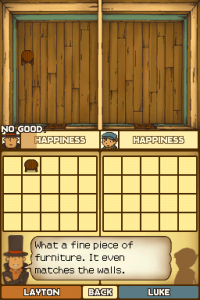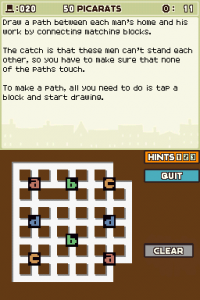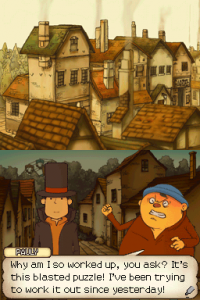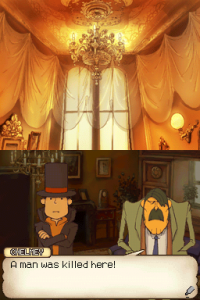Level 5’s Professor Layton series of games started with Professor Layton and the Curious Village (2007) on the DS. This first episode was very successful in Japan and worldwide, which spawned a series of half a dozen episodes on DS then 3DS. The games mix riddles and brainteasers and an adventure game presentation, at a period where the massive success of the DS, as well as its intuitive input method, made it a very attractive platform for casual games and, indeed, brainteasers, sudokus and crossword games. It immediately stood out from its competitors by its framing and the effort that went into its presentation, which we’ll discuss next.
The core gameplay of the series is the numerous riddles you must solve in order to progress; indeed, the number of puzzles in the game is featured prominently on the box art of games of the series (and the European box art of this one). In classic ADV game fashion, you are presented with a first-person view of an area, and must click on a part of the scenery or a character, often triggering a puzzle that you can attempt to solve. Puzzles are self-contained, with instructions in the top screen; you solve the puzzle using the stylus in the bottom screen. Some puzzles are needed to advance the narrative, but most aren’t; however, the game gates your progression at some points, telling you you can only move forward after having solved e.g. 50 puzzles. You are thus strongly encouraged to look around and talk to everyone to get and solve as many puzzles as you can. Should the story progress and leave some unsolved puzzles behind, you have the opportunity to visit Granny Riddleton’s shack, that holds all the puzzles that are not available in the village anymore, in order to complete them. That being said, for the completionists out there, it is still not easy to find 100% of the puzzles, as some will be available (but missable) until the very end, which means they never appear in that shack; the purpose of the shack seems to be to ensure no player gets stuck in a situation where there’s not enough puzzles left to solve in order to pass the next gate.
The puzzles themselves all fall in the brainteasers category, the ones you find in children’s magazines, logic books, etc. In fact, most of them were taken from a popular Japanese series of books by Prof. Akira Tago (Head Gymnastics) featuring hundreds of these over twelve books. However, some of the puzzles (like the sliding blocks puzzles) are original puzzles that were created specifically to use the Nintendo DS’s stylus, and these are actually very nicely done with intuitive controls. The puzzles are of numerous types: pure logic, observation, spatial/visual reasoning, manipulation, mazes, geometry, mathematics, etc. There are no language-based puzzles however, or any based on cultural references, for translatability. Because some puzzles require mathematical reasonings that are a bit abstract, one cannot really recommend this game to children younger than 10. Some of the puzzles might be new to you, but unfortunately there are some really old chestnuts in there, the kind you’re already seen too many times if you like brainteasers: “measuring 4L with two containers of 5 and 3L”, the eight queens problems, magic squares, the wolf the sheep and the cabbage, things that double every minute, the liquid costs 100$ more than the container, etc. There is also the issue that the instructions, contained in the top screen of the DS, are sometimes a little ambiguous (including for the last puzzle unfortunately), which is a shame. Finally, the game also adds three mini-games that require you to collect parts or furniture for a room, which you sometimes get as a reward for solving a puzzle; these games are here to incentivize solving more puzzles, but are definitely on the easy side and won’t keep you busy for very long.
Overall though, the puzzles are a good mix, fairly diverse in their setups and the skills they require. They are also well spread out difficulty-wise. The difficulty of a puzzle is given before the puzzle starts by the number of points (or “picarats”) awarded for solving it, which is a very good idea; these run between 10 and 80, in increments of 5, and overall the number of points matches closely the difficulty and time needed to solve a puzzle. Having such a good and varied indicator allows the player to think things like “this will take me too much time, I’ll solve it later” or “this is a hard one, it’s ok if i don’t get it”, which is a very good thing, allowing to accommodate players of different skill levels. The puzzles also can be tried as many times as one wants; each of the first two incorrect guesses lowers the picarats value of the puzzle, but it never drops very low, meaning that even a player who gets it wrong frequently will still rack up points, which is a nice touch for novices.
Even if the puzzles are at the core of the gameplay, the game is presented as an adventure game, and there is significant production value in it. As Professor Layton and his young apprentice Luke, you enter the village of Saint-Mystère, hired by a baroness to find a treasure. Everything in the game is made to evoke an old-style European feel (circa 1950-1960), perhaps taking inspiration from British crime novels like Agatha Christie’s. It is obvious in the architecture of the village, the model of the car, the accordion-heavy music, the yellow and brown palette of the game, and the British accents of Layton and Luke. Yet, to a European, it feels like an abstract concept of Europe, reinterpreted through a foreign lens, featuring a hodgepodge of names from various countries and nothing specific about the culture, the food, or the geography.
The art style is also a patchwork with some Japanese influences; although Layton’s design is simple and very much in the ligne claire style, and the atmosphere and architecture are clearly European, Luke looks like a youthful wide-eyed shonen protagonist. The half a dozen cutscenes, which are triggered during important story moments, are very well-done, but done quite clearly in the Japanese style, which is especially visible in the chase scenes (in which the characters run like in Lupin III). The character art in general is a bit of a mixed bag; important characters generally get expressive but realistic sprites, as some secondary characters do, while others are striking in their oddity and roughness (bulging eyes, extremely defined lips, odd head shapes, etc) in a way that somehow feels very Japanese. (There are also a couple of unfortunate stereotypes in there.)
All in all, while a lot of work was put into the presentation, the graphical art direction seems a little off-balance. However, it is important to note that the sound design of the game is actually very good. There is very little dubbing, but the voices are well-directed and have good audio quality; the sound effects corresponding to the actions in the game are bright and expressive, in a bit of a playful way; and the music, which mixes accordion and xylophone, creates a nice soft atmosphere. In particular, the music you hear every time you solve a puzzle doesn’t really get tiring even after a few hours of hearing it (however, the music associated with the extra mini-games is grating).
The characters in the game are not much to write home about; they are all rather distinctive and each have their own energy, but don’t really have anything going on besides that, and will mostly be sources of puzzles. (There are about two dozen characters, overwhelmingly male, and you won’t get to know them more than “perpetually angry man” or “odd-looking tourist”.) Actually, if we’re being honest, the Layton character himself isn’t an amazing main protagonist. We know exactly two things about him: that he is the smartest person in the room, and that he is a gentleman (to make him likeable, perhaps?). He always keeps his composure and cools conversations down, which makes for a protagonist with no real flaw, no real emotion shown, no secret, and no motivation besides puzzle-solving. Sherlock Holmes is a dysfunctional grumpy man, Hercule Poirot is overly proud of himself, Phoenix Wright is full of passion for justice, but Layton is just… there, cool as a cucumber. That’s a shame, as a protagonist with more color and texture would have opened more narrative opportunities and made for a richer story.
The story itself unfolds under the eyes of the player in a series of story beats that the player finds while finding clues. It is meandering; you start by looking for a treasure, but you don’t find any clues and get sidetracked by some things (because, of course, there is a murder, and a grumpy inspector that looks down on Layton’s attempts at investigating), until it all falls into place and all the mysteries you encountered get solved. All the player has to do is follow the next objective to unlock more of the story – there is no need for deductions or dialog tree traversal in the game, which also means the story isn’t very tight or follows logical deductions. It relies generously on Layton’s intellect to move the story forward, in which he gets an intuition about what the next plot beat is, or makes a deduction that is a little far out. And although the game is styled after European crime novels of the 20th century, which usually presented a case with impossible facts that were then explained through logic alone, ultimately here the explanation of the mystery relies on Japanese-style magical realism (just as there are mediums in Phoenix Wright) and some emphatic symbolism. All of this could be disappointing if you’re expecting investigations and deductions, but since the game doesn’t brand itself as an investigation game and the story isn’t a gameplay goal of the game (solving the puzzles is), this is fine. We do get as a consequence a nice story and some very striking visuals, such as the tower made of piled-up houses at the center of the village (or the, uh, Dr Robotnik-style baddie and his massive ship).
One of the main narrative hurdles that comes with the bold attempt of mixing two genres so separate (the mystery ADV game and the casual brainteasers) is to try to weave the puzzles into the world and the story. On this point, the game unfortunately doesn’t succeed. The first couple of puzzles are integrated with the story, but not a lot of them are afterwards, and the justifications for the puzzles in the story quickly become either “I’m stuck on this puzzle and it’s keeping me up at night!”, “So you’re Professor Layton? Let’s see if you’re as good as your reputation!”, or “A flower? Luke, that reminds me of a puzzle”. (And each of these justifications is used so many times you get sick of it.) The game is aware of that, and tries to use humor to deflect it (with Layton and Luke saying “Really, right now?!” in a couple of the worst offenders), and also tries to weave it in the setting and the story. In both cases, this comes off as meta, which isn’t the strongest justification writing-wise, more like a deflection; and since it’s the first game of the series, one can rightfully wonder how the series is going to keep this up and keep justifying the hundreds of puzzles in the story. The problem is compounded in the case of the mini-games, which require you to collect furniture or pieces of a painting; while the first thing you collect is integrated to the story, with characters setting up the mini-game or reacting to it, the rest are just random drops after you solve a puzzle, which can feel a bit tacked-on. (It just doesn’t make sense to get a sofa after Layton tells his favorite puzzle to Luke.)
In the end, Professor Layton and the Curious Village is a very interesting concept, mixing two rather separate genres in a unique way. The puzzle-solving aspect is very nicely done, apart from a few quibbles, and exploits the DS’s capacity very nicely; if you like puzzles and brainteasers, this will keep you thinking and entertained for over a dozen hours. However, while there was obviously a lot of effort put into the presentation, the game doesn’t quite gel as a narrative experience or an adventure game; the characters aren’t very deep or interesting, and the writing isn’t particularly good, while the story just exists to move the player along. The strong core gameplay makes the game, but it will be interesting to see how the series progresses on other aspects.
